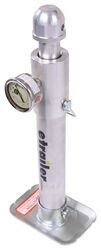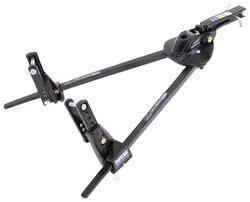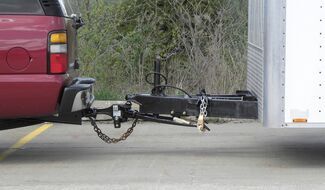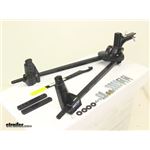
Recommended Weight Distribution System for 10,400 lb GVWR V-Nose Enclosed Cargo Trailer
Question:
I am purchasing a 24 V-Nose enclosed cargo trailer rated at 10,400#. Which weight distribution hitch would you recommend?
asked by: Paul L
Expert Reply:
Assuming that the 10,400 lb figure is the trailer's GVWR, the trailer's tongue weight can potentially be as much as 1500 lbs or as little as 1000 lbs, but it's always a good idea to confirm the trailer's fully loaded and ready to tow tongue weight using a tongue weight scale like the etrailer Tongue Weight Scale # e99044. I'll link to an article that shows a couple of other ways to find the trailer's tongue weight.
Given the GVWR, a 1000 lb tongue weight rated Reese Steadi-Flex like the # RP66559 you'd looked at likely wouldn't have enough capacity. If your as-towed tongue weight will remain under 1400 lbs, a higher-rated version of the Steadi-Flex, part # RP66561 could be a good choice if the V-nose of the trailer doesn't interfere with the top of the trailer frame member on the tongue between 25-32 inches rearward of the trailer ball for the frame brackets to mount. If the frame is inaccessible in that area, you'll need to go another route.
If the top of the frame members are blocked by the V-nose at the typical frame bracket mounting point, you can use a chain suspended system like the Reese Strait-Line, part # RP66130 which is compatible with trailers with tongue weights ranging from 800-1500 lbs. Instead of the chain hanging brackets included with the kit, you'd need bolt on brackets which are sold separately as part # RP58305. Rather than using the lift brackets, you'd use the trailer's jack to raise the trailer coupler while it's still hitched, which will also raise the rear of the tow vehicle. You'll raise the jack until the tension is taken out of the spring bars and the bars can be removed by hand.
Either of these systems offer proven weight distribution combined with excellent resistance to trailer sway. Enclosed trailers are pretty susceptible to trailer sway caused by crosswinds, and oncoming or passing vehicle traffic. The large side of the trailer can act like the sail on a boat, making for a white knuckle ride for the person driving the tow vehicle unless a weight distribution system with a sway control component is used. The weight distributing shanks are sold separately, see the provided link.
For either system, you'll need a # 19286 trailer ball. I've linked to some product videos for the weight distribution systems I recommended.

Products Referenced in This Question
2-5/16" Hitch Ball - 1-1/4" Diameter x 2-3/4" Long Shank - Chrome - 12,000 lbs
- Trailer Hitch Ball
- Trailer Hitch Ball
- Standard Ball
- Chrome-Plated Steel
- 2-5/16 Inch Diameter Ball
- 2-3/4 Inch Shank Length
- 1-1/4 Inch Diameter Shank
- 12000 lbs GTW
- Class IV
- Class V
- Draw-Tite
more information >
etrailer Tongue Weight Scale for Campers and Utility Trailers - 2,000-lb Capacity
- Tongue Weight Scale
- Analog Scale
- 2000 lbs
- etrailer
more information >
Chain Hangers for Reese Weight Distribution Systems - Bolt On
- Accessories and Parts
- Weight Distribution Hitch
- Chain Hangers
- Reese
more information >
Strait-Line Weight Distribution w/ Sway Control - No Shank - Trunnion Bar - 15K GTW, 1,500 lbs TW
- Weight Distribution Hitch
- WD With Sway Control
- Some Sway
- Shank Not Included
- Electric Brake Compatible
- Fits 2 Inch Hitch
- Fits 2-1/2 Inch Hitch
- Allows Backing Up
- 1100 lbs
- 1200 lbs
- 1300 lbs
- 1400 lbs
- Reese
more information >
Product Page this Question was Asked From
Reese Steadi-Flex Weight Distribution System w/ Sway Control - Trunnion - 10K GTW, 1K TW
- Weight Distribution Hitch
- WD With Sway Control
- Some Sway
- Includes Shank
- Electric Brake Compatible
- Surge Brake Compatible
- Fits 2 Inch Hitch
- Allows Backing Up
- 600 lbs
- 700 lbs
- 800 lbs
- 900 lbs
- Reese
more information >
Featured Help Information
Instructions
Miscellaneous Media

Continue Researching
- Article: 5 Things to Know About Weight Distribution Hitches
- Q&A: Weight Distribution Recommendation for 6,000 lb Trailer
- Article: 2 Steps for Finding the Right Weight Distribution Hitch Size
- Article: Which Sway Control Hitch is Right For Your Trailer?
- Q&A: Which System Is Best Between The Curt TruTrack & The Equal-i-zer Weight Distribution System?
- Q&A: Will The Reese Dual Cam II Weight Distribution System # RP65FR Fit 2023 GD Imagine XLS 22RBE?
- Q&A: Where to Mount Spring Bar Support Brackets on Curt TruTrack Weight Distribution System # C17499
- Article: Determining Trailer Tongue Weight
- Article: How to Measure for Trailer Hitch Drop
- Q&A: Recommended Weight Distribution Hitch With Sway Control for Jayco X20E
- Q&A: Will Curt Hitch Ball # A-6 Work on Reese Steadi-Flex Weight Distribution System RP66559
- Article: 5 Tips to Confidently Choose Your Weight Distribution Hitch
- Q&A: Does the Strait-Line Weight Distribution Hitch Allow You to Turn and Back Up at the Same Time?
- Article: Trailer Wiring Diagrams













